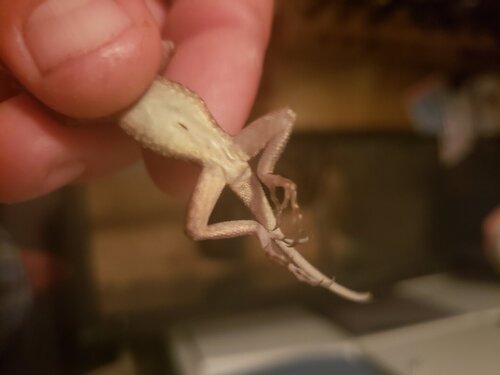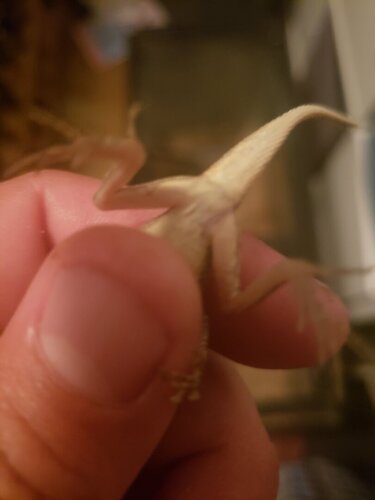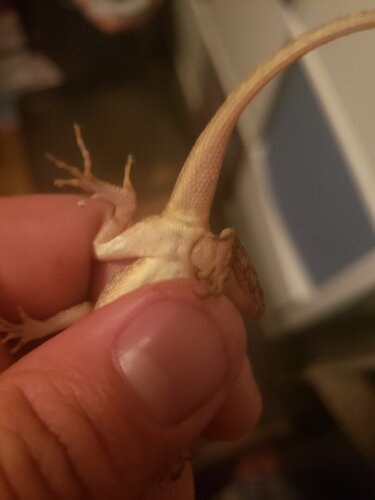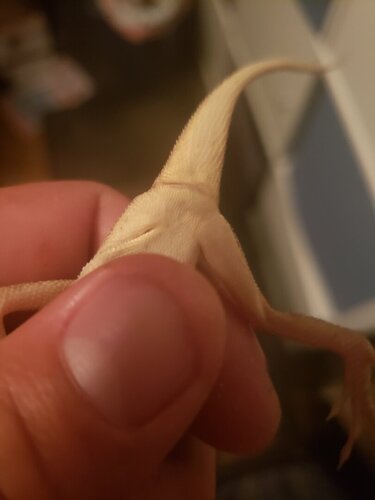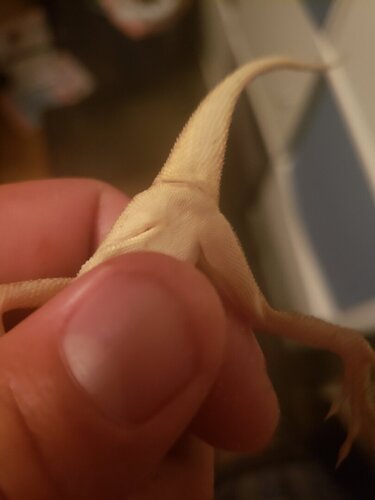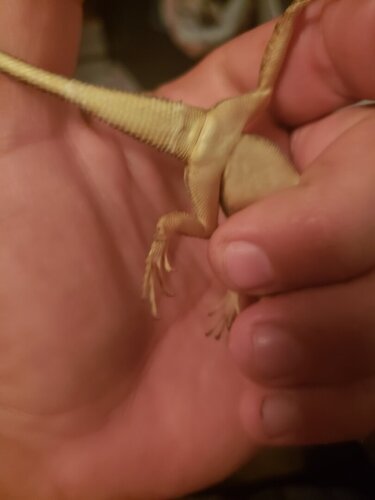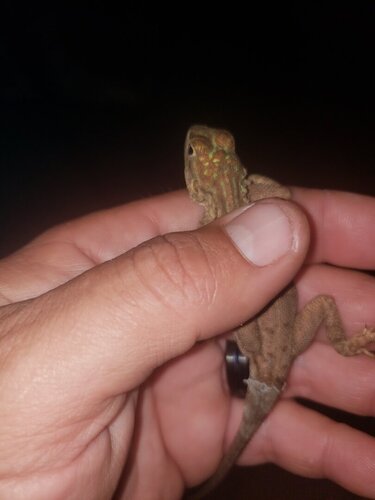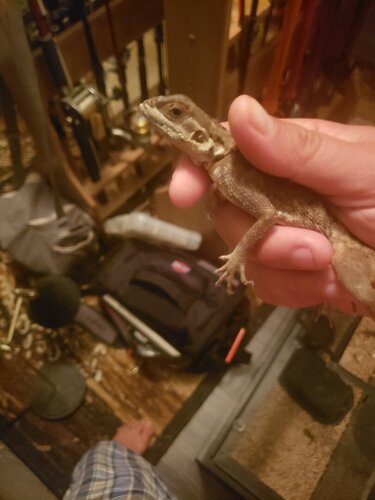Navigation
Install the app
How to install the app on iOS
Follow along with the video below to see how to install our site as a web app on your home screen.
Note: This feature may not be available in some browsers.
More options
You are using an out of date browser. It may not display this or other websites correctly.
You should upgrade or use an alternative browser.
You should upgrade or use an alternative browser.
I know this is a chameleon forum but,..
- Thread starter CHIMP
- Start date
Klyde O'Scope
Chameleon Enthusiast
There's another forum for Other Reptiles And Pets 
MissSkittles
Chameleon Enthusiast
Wow! Those are pretty lizards. Hope they spread a little more north so I can have some in my backyard.
MissSkittles
Chameleon Enthusiast
Yes, I read that they are non-native to Florida...yet another ’invasive’ species. I really dislike that term, “invasive species”. It’s not as though they animals chose to migrate here. Irresponsible humans set them loose. Regardless, they’re very pretty and I look forward to seeing one in my yard someday.
Chase
Chameleon Enthusiast
Yes, I read that they are non-native to Florida...yet another ’invasive’ species. I really dislike that term, “invasive species”. It’s not as though they animals chose to migrate here. Irresponsible humans set them loose. Regardless, they’re very pretty and I look forward to seeing one in my yard someday.
I can see why you dislike the term, but they are invasive to the ecosystem. Even if they came here not by irresponsible humans, they’re still called an invasive species.
Klyde O'Scope
Chameleon Enthusiast
I dislike the term "cage" for where we keep our charges (same for dog crates, which are functionally more like dens, and protect pets when used correctly), so I try to always make it a point to use "enclosure".Yes, I read that they are non-native to Florida...yet another ’invasive’ species. I really dislike that term, “invasive species”. It’s not as though they animals chose to migrate here. Irresponsible humans set them loose. Regardless, they’re very pretty and I look forward to seeing one in my yard someday.
We all have our idiosyncrasies.
IDK if it will help or not. I know a lot of respected scientists & professionals put a lot of research, time, and thought into defining the term "invasive species".
Wikipedia defines it as:
An invasive species is a non-native species that spreads from the point of introduction and becomes abundant.[2]
The invasive species label attaches only to populations of species whose impact upon introduction has altered their new environment.[3] Although this impact can be beneficial, the term as most often used applies to introduced species that affect the invaded habitats and bioregions adversely, causing ecological, environmental, or economic damage.
The National Wildlife Federation defines it as:
An invasive species can be any kind of living organism—an amphibian (like the cane toad), plant, insect, fish, fungus, bacteria, or even an organism’s seeds or eggs—that is not native to an ecosystem and causes harm. They can harm the environment, the economy, or even human health. Species that grow and reproduce quickly, and spread aggressively, with potential to cause harm, are given the label “invasive.”
An invasive species does not have to come from another country. For example, lake trout are native to the Great Lakes, but are considered to be an invasive species in Yellowstone Lake in Wyoming because they compete with native cutthroat trout for habitat.
and The National Oceanic and Atmospheric Administration defines it:
An invasive species is an organism that causes ecological or economic harm in a new environment where it is not native.
Do you have an alternative or preferred term in mind? (Serious question)
MissSkittles
Chameleon Enthusiast
I agree with you on ‘cage’, although I often wonder if it’s just to make myself feel better for keeping animals contained.I dislike the term "cage" for where we keep our charges (same for dog crates, which are functionally more like dens, and protect pets when used correctly), so I try to always make it a point to use "enclosure".
We all have our idiosyncrasies.
IDK if it will help or not. I know a lot of respected scientists & professionals put a lot of research, time, and thought into defining the term "invasive species".
Wikipedia defines it as:
The National Wildlife Federation defines it as:
and The National Oceanic and Atmospheric Administration defines it:
Do you have an alternative or preferred term in mind? (Serious question)
I prefer the term non-native species. The only invasive species is humans. Saving you from my whole long rant about how we damage fragile ecosystems worse than any non-native animal species can.
Chase
Chameleon Enthusiast
I agree with you on ‘cage’, although I often wonder if it’s just to make myself feel better for keeping animals contained.
I prefer the term non-native species. The only invasive species is humans. Saving you from my whole long rant about how we damage fragile ecosystems worse than any non-native animal species can.
They are non-native, but they’re also invasive
Klyde O'Scope
Chameleon Enthusiast
The way we view it, if we're going to include animals in our family, then like family, taking care of—and protecting—them is inherent. Like the crate that protects my service dog from harm when he's not with me, various enclosures protect the others that need protection from the hazards of the human habitat. Beyond that, we provide for them the best that we can, making their lives as comfortable as we can—as we would any family member. If we cannot, then we don't adopt those animals into our care.I agree with you on ‘cage’, although I often wonder if it’s just to make myself feel better for keeping animals contained.
Not everyone may agree with that view. ?
I prefer the term non-native species. The only invasive species is humans. Saving you from my whole long rant about how we damage fragile ecosystems worse than any non-native animal species can.
Long rant is not necessary. I would agree that humans do more than our share of damage to the planet.
However, some species do migrate and adapt to new/different habitats as conditions in their "native" habitat change. That is essentially what humans did as we migrated out of Africa. The difference between that and being "invasive" is (IMO) whether it occurs naturally (according to Nature) or artificially (which—granted—may be an abstract concept and arguable).
Just my opinion. ? We're just exchanging ideas.
CHIMP
Established Member
So I definitely sparked a conversation here. I would like to add my two cents for what it is worth lol, "invasives" to use the term definaltey cause changes to the ecology of an area but long term effects have shown that alot end up finding a nitch in the pecking order. They can wipe out native species. But different things bring them together all the time. Not just humans. I do not see them saying we can't own a cat.. I say if they are here to stay then so be it. Dogs, cats, rats, rabbits, etc.. do the same thing. I just want the government to stop putting restrictions on animals that have already adapted. Prime examples being iguanas and Burmese pythons.
CHIMP
Established Member
They all look the same to me, I see nothing to distinguish. No bulge, pores, spikes.Take a picture of their bellies and l’ll try to help
Attachments
CHIMP
Established Member
Please take pics for us when you have some time!!!
Attachments
Klyde O'Scope
Chameleon Enthusiast
One method of sexing very young varanids utilizes a flashlight shined through the posterior side to better see the internal structures.They all look the same to me, I see nothing to distinguish. No bulge, pores, spikes.
It works very well on bearded dragons (agamidae) so it may work on others in that family as well.
Couldn't hurt to try.
Hemipenal Transillumination as a Sexing Technique in Varanids
Klyde O'Scope
Chameleon Enthusiast
And now perhaps some controversy as well.So I definitely sparked a conversation here. I would like to add my two cents for what it is worth lol, "invasives" to use the term definaltey cause changes to the ecology of an area but long term effects have shown that alot end up finding a nitch in the pecking order. They can wipe out native species. But different things bring them together all the time. Not just humans. I do not see them saying we can't own a cat.. I say if they are here to stay then so be it. Dogs, cats, rats, rabbits, etc.. do the same thing. I just want the government to stop putting restrictions on animals that have already adapted. Prime examples being iguanas and Burmese pythons.
Are you seriously trying to equate iguanas and Burmese pythons with cats & dogs‽
Cats and dogs have been domesticated for many thousands of years. Iguanas and Burmese pythons are not domesticated.
Domesticated animals are animals that have been selectively bred and genetically adapted over generations to live alongside humans. They are genetically distinct from their wild ancestors or cousins.
https://www.nationalgeographic.com/animals/reference/domesticated-animals/
I'll leave it at that. I had typed a lot more, but I deleted it. I think we've gone far enough astray.
Chase
Chameleon Enthusiast
They all look the same to me, I see nothing to distinguish. No bulge, pores, spikes.
Pores are not on the underside of the hind legs like we’d normally look for (if I’m not mistaken). If I remember correctly, they are on the belly and look like a zipper for males but these may be too small to see that.
CHIMP
Established Member
I am not trying to compare anything. Just chatting. And yes cats and dogs have been domesticated for thousands of years but when people do not take proper care. They can cause problems in the local environment. So when it comes to invasive species, and laws regarding what we can and can not have, they are no different. My point was that there are many other factors regarding invasives. Not just the pet trade. Or strictly speaking anything other than a cat or dog. For example Charly tails comming off boats, or tarantulas in banana. As long as there are is a way to migrate they find a way.And now perhaps some controversy as well.
Are you seriously trying to equate iguanas and Burmese pythons with cats & dogs‽
Cats and dogs have been domesticated for many thousands of years. Iguanas and Burmese pythons are not domesticated.
I'll leave it at that. I had typed a lot more, but I deleted it. I think we've gone far enough astray.
Last edited:
Similar threads
- Replies
- 0
- Views
- 246







